Reservoir filling: implications for reservoir geochemistry

Enhanced understanding of the fluid properties offers many opportunities for insightful and low-cost approaches to field management and problem solving, from compartmentalisation studies to production allocation and monitoring.
This short technical note discusses concepts around how petroleum reservoirs are thought to fill and how that process impacts the understanding of reservoir fluid’s geochemistry and PVT properties such that these tools can be deployed effectively.
Written by: Dr. Julian Moore, Group CTO
While geologists spend much time and effort on the static description of a reservoir (poro-perm, continuity, structural heterogeneity), the fluid description is often treated simply and only considered at the point of sanction. This almost certainly means that opportunities for enhanced understanding and more effective management and exploitation strategies are missed. If deployed appropriately, reservoir geochemistry can be a flexible, cost-effective tool to help with the parameterisation and management of petroleum reservoirs. As a discipline, reservoir geochemistry aims to exploit identifiable heterogeneity in fluid geochemistry to provide insight to its subsurface continuity and fluid physical properties; for example, most if not all oil fields have gradients in bulk properties such as API and GOR. These properties are crucial to valuing a petroleum asset and mapping their variation will provide insight to the reservoir system. As a concept, reservoir geochemistry is certainly not new, many of the ideas and concepts were available in the 1980s and 1990s; Larter & Aplin (1995) were perhaps the first to draw together a holistic framework for the discipline. Despite providing a direct assessment of the fluids of primary interest in any field exploitation scheme, at very low-cost, the take up of reservoir geochemistry as a discipline has been at best modest. This is likely to reflect a range of issues, from knowledge within field development teams to perceptions of the tools as unproven or superfluous.
The first papers to set out the physical processes involved in the accumulation of petroleum within a trap in the subsurface were set out by England et al. (1987) and the implications of these processes for reservoir geochemistry were further considered by England (1990) on the Forties Field, UK North Sea (Figure 1). In this model the initial charge is heterogenous and is mixed towards an equilibrium state by diffusional processes in a vertical sense and by density driven overturning in a lateral sense.
Following publication of the BP model, it has been commonly assumed that petroleum charge homogenizes within the trap, and thus compositional gradients reflect the physical forces the petroleum column is subject to (gravity, temperature, diffusion, etc). However, Stainforth (2004) argues that this would entail an unfavourable generation of potential energy. In his paper he considers two end-member models: one where petroleum charge mixes perfectly within the trap and a second where it does not mix at all. These end-member models are considered further in this note.
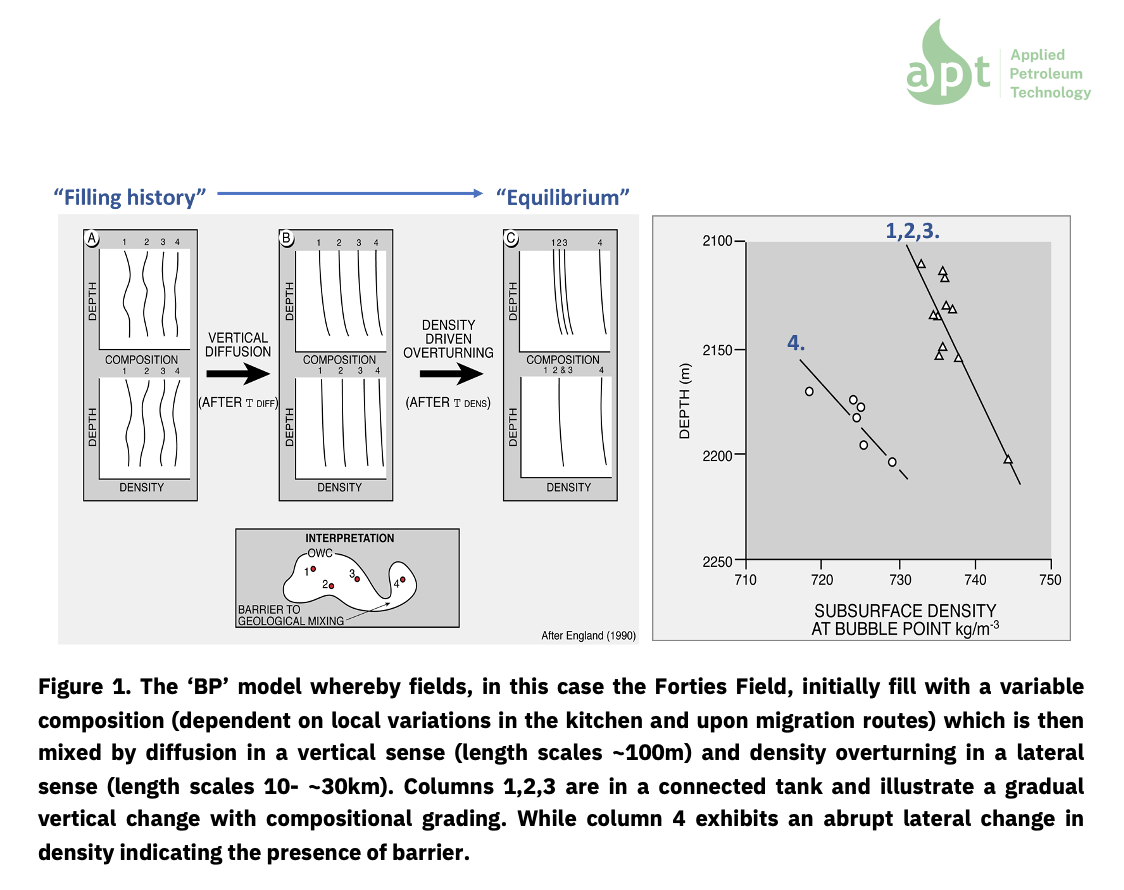
Integrating PVT data is a crucial aspect of any reservoir geochemistry study. Saturation pressures (Pb = bubble point; Pd = dew point) have a strong influence on production behaviour, however these parameters are often treated in a simple way i.e.
- Values are constant in depth (Figure 2A)
- Values are equal to reservoir pressures (Figure 2B)
Field data rarely conform to such assumptions and depth plots are often curved (Stainforth 2004 and refs. therein), only converging at the GOC i.e. the only place the oil is fully saturated is immediately at the contact (Figure 2C &D). Subsurface petroleum accumulations are only in local thermodynamic equilibrium near the contact, with the degree of undersaturation potentially decreasing so rapidly that bubble point decreases with depth in an absolute sense (Figure 2D).
Reservoir geochemistry studies often start with the assertion that a field is homogenous and connected. The geochemistry of samples is quantified and differences above analytical error are used to invoke compartmentalisation.
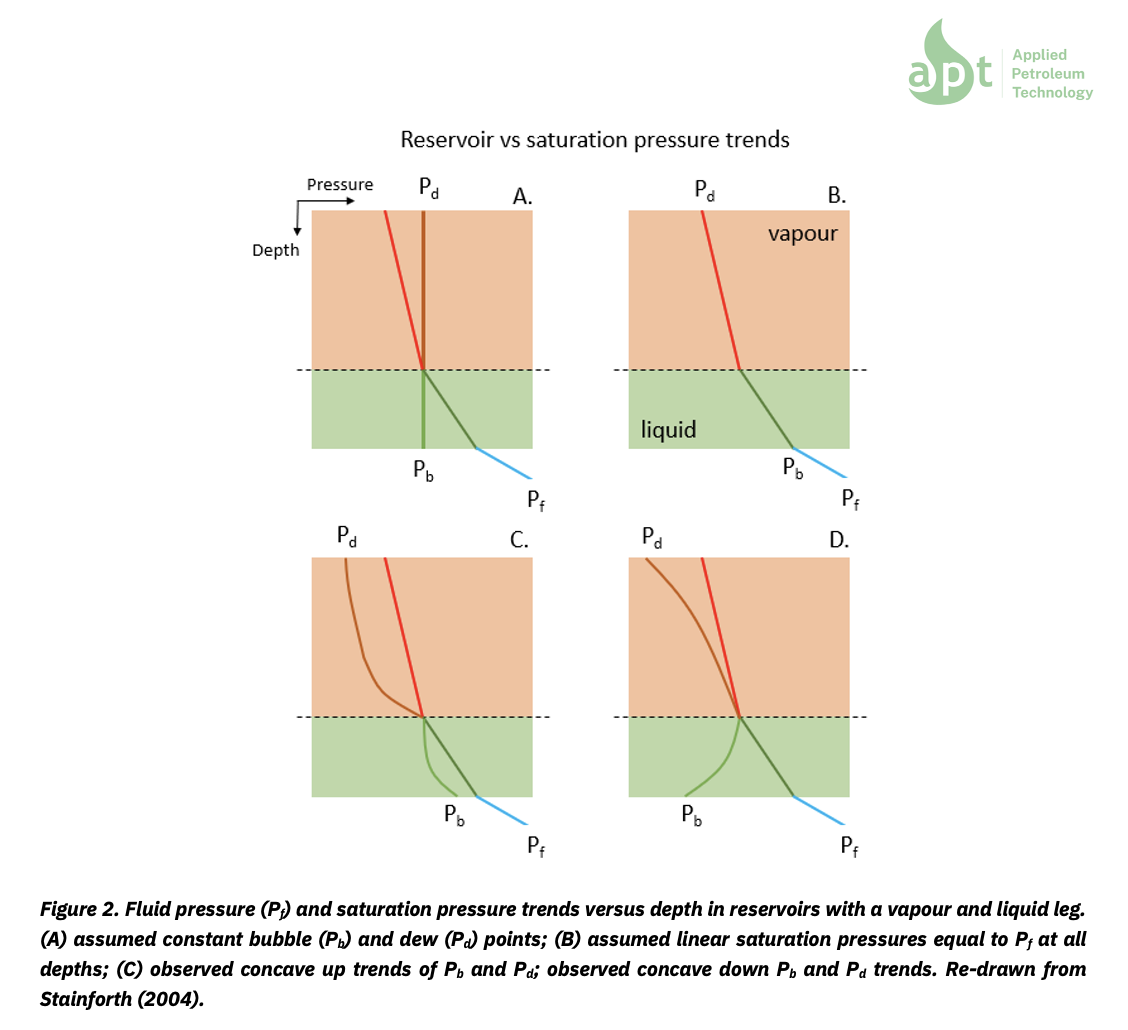
In the oil industry composition grading, if considered at all, is commonly assumed to only occur in long petroleum columns as a result of gravitational forces. Neither of those assumptions is true. Grading is probably ubiquitous to petroleum columns irrespective of column height or phase (cf. Figure 3; Figures 5-9 in Stainforth, 2004). Thus, caution is required since comparing a sample from a shallow point in the column with a deep one may incorrectly invoke a barrier. What we typically observe is:
- In stacked, discrete oil reservoirs, trends of increasing API, GOR and Pb with increasing depth
- Within oil reservoirs, trends of an opposite sense, where API, GOR and Pb tend to decrease with depth. Stainforth (2004) interprets these vertical trends as the vertical components of lateral trends – present due to the aspect ratios of most petroleum fields and the inability of lateral diffusion to homogenize the oil in the time since charge (cf. Figure 4).
Stainforth (2004) proposed two end member models that account for the occurrence of grading in petroleum columns:
- Model 1: Charge – instantaneous, perfect mixing (via diffusion and/or convection?) →gravity & temperature induced grading (or biodegradation induced) (~BP model; Figure 1).
- Model 2: Charge – no mixing → stacking according to density (Figure 5) → diffusion towards less graded columns in equilibrium with temperature and gravity fields (relatively ‘fast’ vertically mixing, geologically slow mixing laterally).
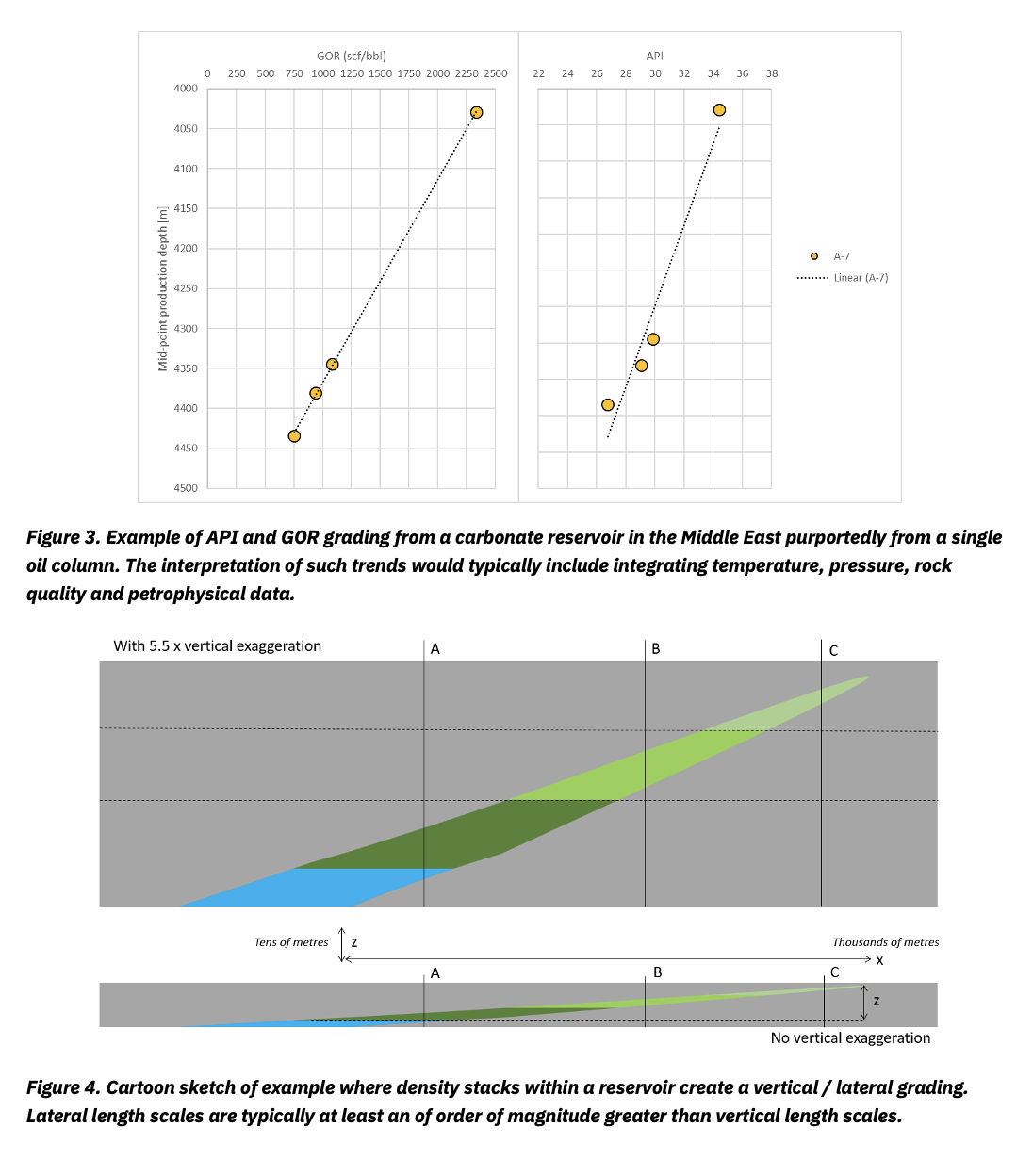
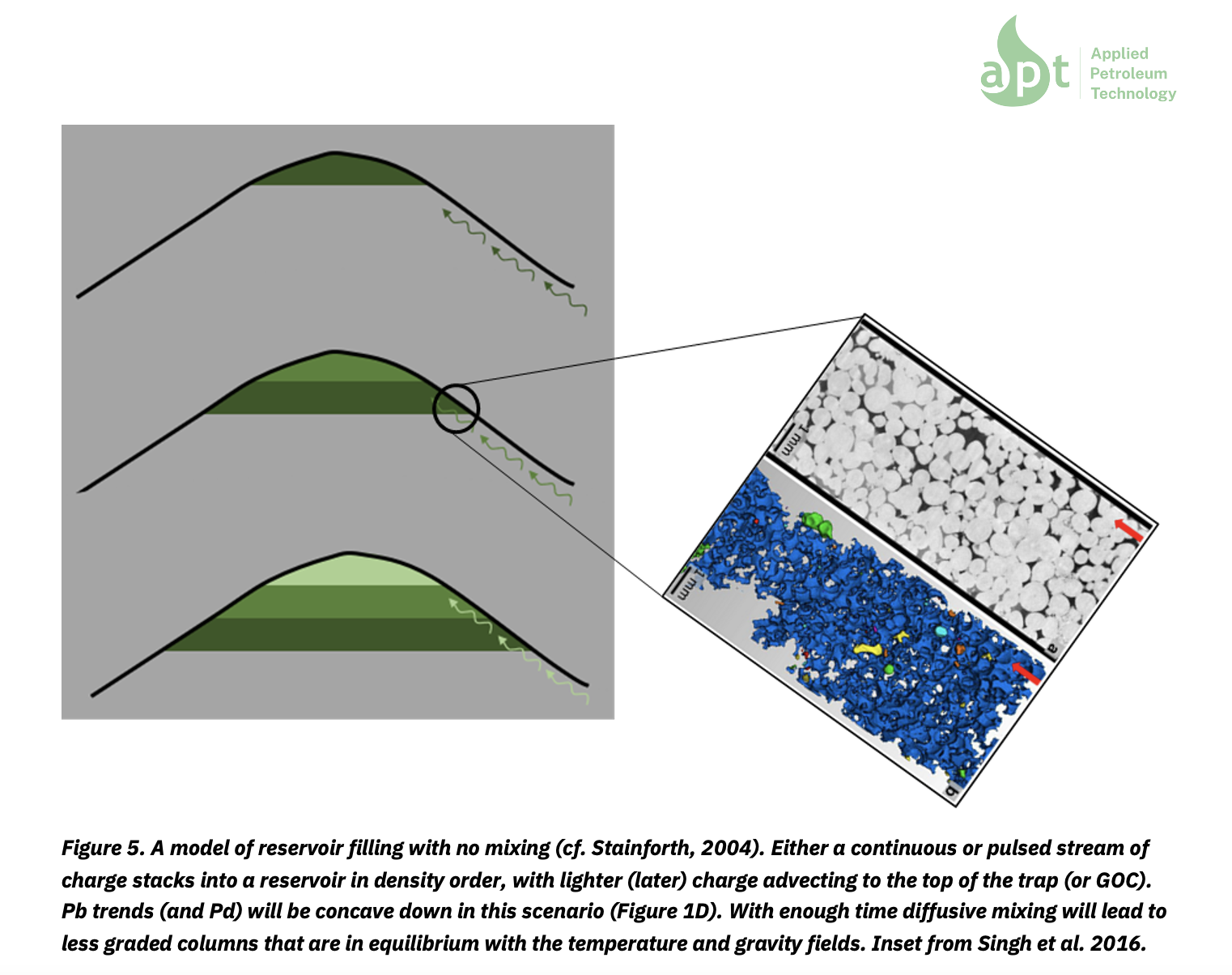
A key process in the mixing and homogenising of a petroleum accumulation invoked by Model 1 is diffusion; however, this process has been shown to be typically inadequate to entirely homogenise petroleum fields (e.g., England et al. 1987). Reflecting the diffusion coefficients relative to the length scales involved: a field will typically have a lateral extent (usually kilometres) at least an order of magnitude greater than its vertical extent (typically tens of metres). Diffusion is only likely to be of importance in thick homogeneous reservoirs with long residence times. Thus, the fundamental process underpinning Model 1 is likely to be significant within a vertical section but insignificant laterally in most geological situations.
By considering how fields fill, we may arrive at a better model to explain the common occurrence of graded petroleum columns. In most, but not all, scenarios petroleum charge will become progressively lighter (lower density) with time as the basin is buried and the kitchen increases in temperature. Fluid migrates along reservoir-seal interfaces, once it enters the trap, since diffusive mixing is slow, the most recently arrived (lightest) petroleum will advect through the existing petroleum, as ganglia, to the crest of the trap, displacing heavier petroleum downwards (Figure 5). Diffusive mixing will slowly evolve this stacked accumulation towards equilibrium with the temperature and gravity field. This model is opposite to that proposed in Model 1 where a homogenous but unstable column evolves to a stable equilibrium condition. The subtlety here is that in Model 1 Stainforth assumes a perhaps common belief that reservoirs fill initially from the top downwards such that the youngest petroleum is initially at the base of the column; his argument being that since it is likely the lowest density (highest GOR) this would be unstable. In Stainforth’s model fields stack downwards such that the youngest petroleum advects to the top and then displaces downwards such that the oldest petroleum is at the base of the column – which will then mix over geological time.
Is Stainforth’s model valid? While a useful theoretical framework, there are examples of fields that show the opposite behaviour from that expected from the Stainforth model. One of which is the Buzzard field, located in the outer Moray Firth of the UKCS. The field is large with a STOIIP >1 billion barrels. The reservoir is formed by sand lobes deposited within the KCF source rock and stratigraphically trapped up-dip to the west. Overall, the reservoir geochemistry performed during the E&A phase indicated that the oils were very homogenous (Figure 6a). The oil gravity exhibited a very small variation between 31.6° and 32.6° within the main field, only increasing to the more mature northern part of the field to 33.5° (20/1-3) and 38.3° (20/1-5). Some subtle differences in the isotope ratios of the hydrocarbons were recognised by Beilby et al. (2009); plotting the ethane isotope (normalised to the associated oil sample saturate fraction isotope – removing source facies effects) against depth revealed a trend (Figure 6b). The isotopic difference between the gas and the associated oil will decrease with increasing maturity thus the observed trend indicates that the least mature charge occupies the crest of the field with the highest maturity charge at the base.
This is the inverse of the situation expected according to the Stainforth model! Does this fundamentally break the Stainforth model? I don’t think so, but it does illustrate the need to always integrate the geology of the field under evaluation. There are some aspects to Buzzard that may account for why the configuration expected by Stainforth model is not observed. Firstly, the field is composed of a strat trap, enchased in early mature to mature source rock, thus migration distances are probably very local. Secondly, the oil has a very limited range of maturity (cf. Beilby et al. 2009) and hence oil gravities and GORs (~230 – 300scf/bbl), which may mean the density differences are too slight to vertically stack the charge as Stainforth envisages; perhaps a density differential threshold needs to be met before the model can be invoked? Thirdly, following the initial stage of production and continued data acquisition to determine stratigraphic correlation of the reservoir units, it has been shown the main B4 reservoir is composed of multiple units with extensive shales acting as vertical baffles (Ray et al. 2010).
Notwithstanding the first two observations, the fact that the E&A data did not correspond to the Stainforth model perhaps should have been taken as an indication of the presence of these shales? Finally, one element that has not been touched upon is the time dimension. This will be discussed in another note.
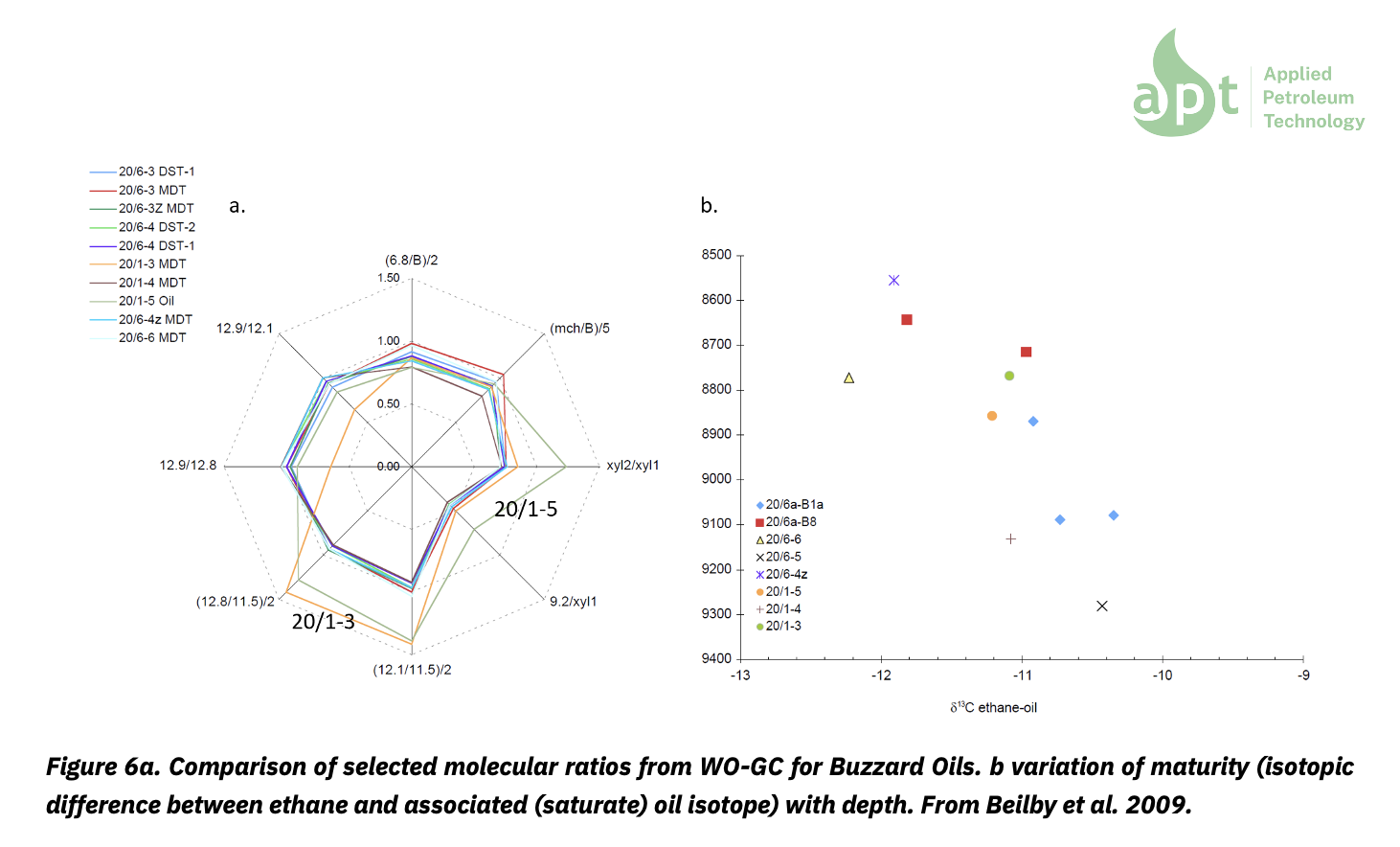
So, what are the implications for reservoir geochemistry?
The starting point of any reservoir geochemistry study is always a review of the available samples, their quality and distribution within the geological framework of the field under evaluation. Contamination can often be an issue and needs careful consideration. The possibility of access to future samples will be determined by the current field development plan and the nature of the production facility (wet vs dry trees).
Early recognition of compartmentalisation is crucial, if it is to make a material impact on development planning, therefore an appropriate level of sampling should be considered through the appraisal stage such that the techniques discussed here can be deployed. This requires early engagement with multidisciplinary teams.
Most of the discussion in this note has related to bulk properties such as API and GOR, whereas reservoir geochemistry may use a range of compounds from gases (C1-C5), Light hydrocarbons (C6-C10) to biomarkers (C20+). The bulk physical properties such as saturation pressure, of interest to engineers, are strongly controlled by the gas and liquid composition. Engineers will split the composition into (pseudo)component groups. What may be a life’s worth of a geochemist’s research is unceremoniously lumped into a C15+ or even a C6+ fraction! This is entirely appropriate since it allows engineers to model a simplified composition efficiently in order to answer the questions they are asked. The challenge to geochemists in reservoir studies is two-fold. Firstly, they need to understand what engineers do, what challenges they face and how geochemistry may shine a light where standard engineering practice cannot. Secondly, the geochemist must decide what degree of difference in their geochemical data is meaningful, with the (ubiquitous) presence of grading further complicating matters. If differences are observed they then need to be interpreted with regards to their implications with respect to connectivity. However, because geochemical studies will typically assess individual compound classes that may have a narrow range of molecular weights (if only gasolines or biomarkers are focused on for example), since they segregate little (cf. Kaufman et al.1990) compared with bulk properties, trends may not agree nor yield equivalent information on connectivity. To make inferences about connectivity both need to be considered; for example, Westrich et al. (1996, 1999) studied the Bullwinkle Field (Gulf of Mexico) which shows very strong compositional gradients but homogeneous geochemical fingerprints indicating the presence of a graded column in a connected reservoir. Both observations have significance for reservoir effective and efficient exploitation.
Reservoir geochemistry studies should always integrate bulk (PVT) properties together with the geochemical data. The geochemical data need to be viewed with respect to the geometry and length scales of the reservoir and an estimate of the time it would take to homogenize the oil by convection/diffusion versus the time of charging the trap (e.g. Smalley & Hale, 1996). In addition, any in-reservoir processes such as biodegradation that may be operative over short geological time frames that could modify fluids must also be considered.
APT has significant expertise in reservoir geochemistry and relevant experience in both the service and operator environment to effectively design and deploy impactful studies. Key to success is clear framing of the problem to be solved, well thought out sample collection, data integration, data quality and execution aligned with the field development plan.
For more information contact: julian.moore@apt-int.com.
Acknowledgments: Thanks to Eric Michael, Richard Patience and Mark Bastow of APT AS, Maurice Bamford of Alisanos Geoscience and Brian Moffatt of Petrophase whose comments are gratefully acknowledged.
References:
Beilby, P., Clayton, C. & Moffat, B. 2009. Distribution of Hydrogen Sulphide in the Buzzard Field. SPE 123875.
England, W.A., Mackenzie, A.S., Mann, D., & Quigley, T.M. 1987. The movement and entrapment of petroleum fluids in the subsurface. Journal of the Geological Society of London, 144, pp. 327 – 347.
W. England. 1990. The organic geochemistry of petroleum reservoirs. Organic Geochemistry 16, 415–425
Kaufmann, R.L., Ahmed, A.S., & Elsinger, R.J. 1990. Gas chromatography as a development and production tool for fingerprinting oils from individual reservoirs: applications in the Gulf of Mexico. In: Schumaker, D. & Perkins, B.F. (eds) Proceedings of the 9th Annual Research Conference. Society of Economic Paleontologists and Mineralogists, October 1990, New Orleans, pp. 263 – 282.
Larter, S.R. & Aplin, A.C. 1995. Reservoir geochemistry: methods, applications and opportunities. In: Cubitt, J.M. & England, W.A. (eds) 1995. The Geochemistry of Reservoirs, Geological Society Special Publication, No. 86, pp. 5 – 32.
Ray, F.M., Pinnock, S.J., Katamish, H. & Turnbull, J.B. 2010. The Buzzard Field: anatomy of the reservoir from appraisal to production. In: Vining, B.A. & Pickering, S. C. (eds) Petroleum Geology: From Mature Basins to New Frontiers – Proceedings of the 7th Petroleum Geology Conference, 369–386. DOI: 10.1144/0070369
Singh, K., Bijeljic, B., & Blunt, M.J. 2016. Imaging of oil layers, curvature and contact angle in a mixed-wet and a water-wet carbonate rock. Water Resources Research, 52, pp. 1716 – 1728.
Stainforth, J.G. 2004. New insights into reservoir filling and mixing processes. In: Cubitt, J.M., England, W.A. & Larter, S.R. 2004. Understanding Petroleum Reservoirs: towards an Integrated Reservoir Engineering and Geochemical Approach. Geological Society Special Publication, No. 237, pp. 155 – 132.
Smalley, P.C., & Hale, N.A. 1996. Early identification of reservoir compartmentalization by combing a range of conventional and novel data types. Society of Petroleum Engineers, Paper No. 30533.
Westrich, J. T., Knigge, P. O., Fuex, A. N. & Halpern, H. I. 1996. Evaluating reservoir architecture in the northern Gulf of Mexico using oil and gas chemistry. Society of Petroleum Engineers, Paper No. 36541.
Westrich, J. T., Fuex, A. N., O'Neal, P. M. & Halpern, H. I. 1999. Evaluating reservoir architecture in the Northern Gulf of Mexico with oil and gas chemistry. Society of Petroleum Engineers, Paper No. 59518.